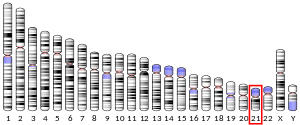PCP4
Purkinje cell protein 4 is a protein that in humans is encoded by the PCP4 gene.[5][6][7] Also known as PEP-19, PCP4 is a 7.6 kDa protein with an IQ-motif that binds to calmodulin (CaM).[8] PCP4 is abundant in Purkinje cells of the cerebellum, and plays an important role in synaptic plasticity.[8][9]
Function
PCP4 knockout mice have been reported to exhibit impaired locomotor learning and markedly altered synaptic plasticity in cerebellar Purkinje neurons.[8] PCP4 accelerates both the association and dissociation of calcium (Ca2+) with calmodulin (CaM), which is postulated to influence the activity of CaM-dependent enzymes, especially CaM kinase II (CaMK-II).[8][10][11]
References
- 1 2 3 GRCh38: Ensembl release 89: ENSG00000183036 - Ensembl, May 2017
- 1 2 3 GRCm38: Ensembl release 89: ENSMUSG00000090223 - Ensembl, May 2017
- ↑ "Human PubMed Reference:".
- ↑ "Mouse PubMed Reference:".
- ↑ Chen H, Bouras C, Antonarakis SE (Jan 1997). "Cloning of the cDNA for a human homolog of the rat PEP-19 gene and mapping to chromosome 21q22.2-q22.3". Hum Genet. 98 (6): 672–7. PMID 8931698. doi:10.1007/s004390050282.
- ↑ Cabin DE, Gardiner K, Reeves RH (Dec 1996). "Molecular genetic characterization and comparative mapping of the human PCP4 gene". Somat Cell Mol Genet. 22 (3): 167–75. PMID 8914602. doi:10.1007/BF02369907.
- ↑ "Entrez Gene: PCP4 Purkinje cell protein 4".
- 1 2 3 4 Wei P, Blundon JA, Rong Y, Zakharenko SS, Morgan JI (2011). "Impaired locomotor learning and altered cerebellar synaptic plasticity in pep-19/PCP4-null mice". Mol. Cell. Biol. 31 (14): 2838–44. PMC 3133400
 . PMID 21576365. doi:10.1128/MCB.05208-11.
. PMID 21576365. doi:10.1128/MCB.05208-11. - ↑ Sangameswaran L, Hempstead J, Morgan JI (1989). "Molecular cloning of a neuron-specific transcript and its regulation during normal and aberrant cerebellar development". Proc. Natl. Acad. Sci. U.S.A. 86 (14): 5651–5. PMC 297682
 . PMID 2748608. doi:10.1073/pnas.86.14.5651.
. PMID 2748608. doi:10.1073/pnas.86.14.5651. - ↑ Putkey JA, Kleerekoper Q, Gaertner TR, Waxham MN (2004). "A new role for IQ motif proteins in regulating calmodulin function.". J. Biol. Chem. 278 (50): 49667–70. PMID 14551202. doi:10.1074/jbc.C300372200.
- ↑ Kleerekoper QK, Putkey JA (2009). "PEP-19, an intrinsically disordered regulator of calmodulin signaling". J. Biol. Chem. 284 (12): 7455–64. PMC 2658041
 . PMID 19106096. doi:10.1074/jbc.M808067200.
. PMID 19106096. doi:10.1074/jbc.M808067200.
Further reading
- Hubert RS, Korenberg JR (1997). "PCP4 maps between D21S345 and P31P10SP6 on chromosome 21q22.2→q22.3.". Cytogenet. Cell Genet. 78 (1): 44–5. PMID 9345904. doi:10.1159/000134623.
- Utal AK, Stopka AL, Roy M, Coleman PD (1998). "PEP-19 immunohistochemistry defines the basal ganglia and associated structures in the adult human brain, and is dramatically reduced in Huntington's disease.". Neuroscience. 86 (4): 1055–63. PMID 9697113. doi:10.1016/S0306-4522(98)00130-4.
- Hu YH, Warnatz HJ, Vanhecke D, Wagner F, Fiebitz A, Thamm S, Kahlem P, Lehrach H, Yaspo ML, Janitz M (2006). "Cell array-based intracellular localization screening reveals novel functional features of human chromosome 21 proteins.". BMC Genomics. 7: 155. PMC 1526728
 . PMID 16780588. doi:10.1186/1471-2164-7-155.
. PMID 16780588. doi:10.1186/1471-2164-7-155.
 . PMID 21576365. doi:10.1128/MCB.05208-11.
. PMID 21576365. doi:10.1128/MCB.05208-11. . PMID 2748608. doi:10.1073/pnas.86.14.5651.
. PMID 2748608. doi:10.1073/pnas.86.14.5651. . PMID 19106096. doi:10.1074/jbc.M808067200.
. PMID 19106096. doi:10.1074/jbc.M808067200. . PMID 16780588. doi:10.1186/1471-2164-7-155.
. PMID 16780588. doi:10.1186/1471-2164-7-155.



